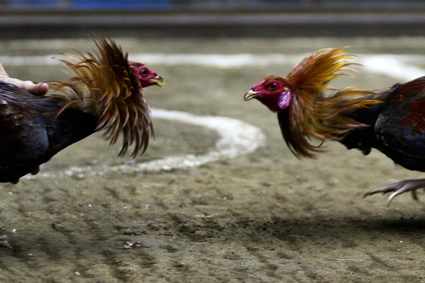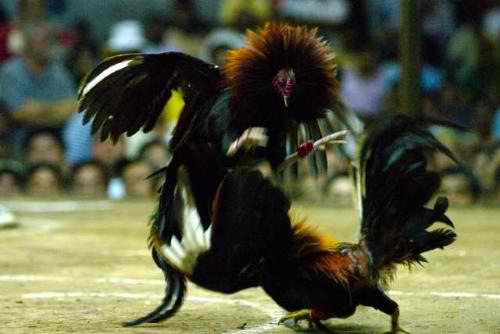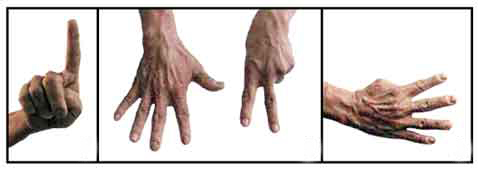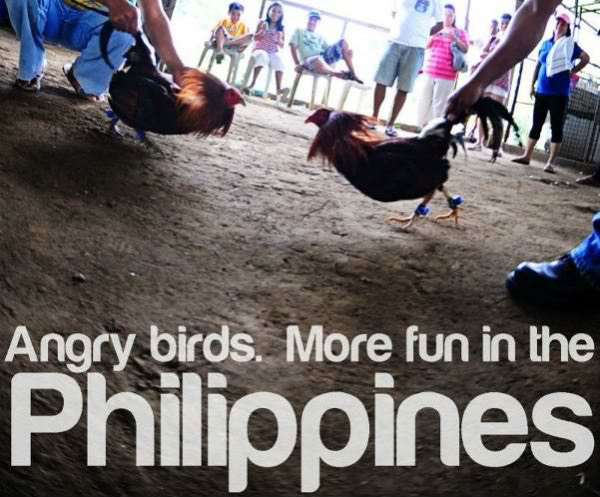 ‘Sabong‘, as it is known locally here in the Philippines, is what we commonly know as simply ‘Cock-Fights’. It has been a part of the Philippine culture since before the time of Magellan. Prior to looking into the history, I had thought that Filipinos picked up on it from Spain during the 1300’s. However Magellan’s historian (Pigafetta) made the following notation when they landed at the island of Palawan, “We found the natives fighting huge, but tamed roosters.” This would place Sabong as part of Philipino history going back at least 700 years.
‘Sabong‘, as it is known locally here in the Philippines, is what we commonly know as simply ‘Cock-Fights’. It has been a part of the Philippine culture since before the time of Magellan. Prior to looking into the history, I had thought that Filipinos picked up on it from Spain during the 1300’s. However Magellan’s historian (Pigafetta) made the following notation when they landed at the island of Palawan, “We found the natives fighting huge, but tamed roosters.” This would place Sabong as part of Philipino history going back at least 700 years.
The day’s fights are first prepped during the Ulatan phase. Outside the arena, in the holding-pen area.. the fighting cocks are paired up based on similar weight, wing span, etc. so the matches are as fair as possible. Once this pairing has been established each bird is fitted with a single, sharp blade.. usually on the left foot. It is shaped like a small sickle or spur about 2 to 3 inches in length.
The next step takes place inside the arena, known as the Ruweda. There are four men in the arena with the fighting cocks; the 2 Owners of the birds, the Announcer (known as the Casador) and the Referee (known as the Sentensyador). The ruling of the Sentensyador is final and there is no appeal regarding the outcome of the fight. Most often it is plainly obvious who the loser is by the end of the match. Once inside the two cocks are held by each owner and allowed to get just close enough to peck at each other. This is done to give the spectators and prospective gamblers an idea of which bird seems the more aggressive. The two owners will then back away from each other and each cock is allowed a minute or so to “strut his stuff”, again so gamblers can assess who to bet on.
final and there is no appeal regarding the outcome of the fight. Most often it is plainly obvious who the loser is by the end of the match. Once inside the two cocks are held by each owner and allowed to get just close enough to peck at each other. This is done to give the spectators and prospective gamblers an idea of which bird seems the more aggressive. The two owners will then back away from each other and each cock is allowed a minute or so to “strut his stuff”, again so gamblers can assess who to bet on.
However it is only once the Casador (announcer) shouts out, “Larga na!!” that all chaos breaks loose. For it is at this point that the gamblers begin shouting in a mad frenzy to place their bets from the stands. Within the stands are the person who take the bets, known as the Kristos. They get this name for having their arms spread out as they signal the bets with hand motions. There are other persons who act as ‘bookies’ who will combine your bet with theirs to get better odds, but most people make their bets directly with the Kristos. It is very loud and chaotic at this point because only about 3-4 minutes are allowed for betting prior to each match. Once the Casador announces the END of betting, the next stage begins and no more bets are taken.
Regarding the hand-signals for placing bets, a system is used to communicate with the Kristos as to how much of a bet is being placed over the loud shouting that ensues. First one must make eye-contact with the Kristos. Then point to which side of the arena the bird he is betting on, the ‘favorite’ or the ‘underdog’. Next the bet amount is indicated with hand-signals, which the Kristos repeats and points to you to confirm the bet. By pointing fingers ‘UP’, it denotes a bet of each 10 Pesos. So.. one finger for 10P bet. Pointing fingers to the side, sideways, indicates one finger per 100 Pesos. So, 4 fingers sideways for a 400P wager. Finally, ‘downward’ pointed fingers indicate the 1,000 Peso bet. Seven fingers down for a 7,000P wager.
one must make eye-contact with the Kristos. Then point to which side of the arena the bird he is betting on, the ‘favorite’ or the ‘underdog’. Next the bet amount is indicated with hand-signals, which the Kristos repeats and points to you to confirm the bet. By pointing fingers ‘UP’, it denotes a bet of each 10 Pesos. So.. one finger for 10P bet. Pointing fingers to the side, sideways, indicates one finger per 100 Pesos. So, 4 fingers sideways for a 400P wager. Finally, ‘downward’ pointed fingers indicate the 1,000 Peso bet. Seven fingers down for a 7,000P wager.
At this point the actual battle begins. The roosters are placed within 12 feet of each other allowed to naturally decide when the bout will begin. At this point the Owners must back away or risk being forfeited for interference. Once the cocks are set loose only the Sentensyador (referee) is allowed to reset the birds into a fighting position or inspect the birds to make a final decision. He is also the only one allowed within six feet of the actual combat.
Most matches last between 2 to 5 minutes at the longest. I have seen several matches in which the two birds ran straight for each other, had a 2 second mid-air conflict and instantly one bird fell to the ground fatally losing the match. It can happen that quickly so everyone is in a heightened state of attention once the birds are set loose for each fight.
To one side of the arena is the area for the birds known as the ‘Meron’. The Meron cock is the champion, or ‘favored’ bird in the betting stats. The fact that he even survived from his last bout to appear is something taken into consideration. But for many Meron birds it is their first fight, however these are the owners with large money behind them who have a  reputation for raising game-winning birds. The cocks are given the best food, vitamins and well cared for in order to give them every possible edge in winning its upcoming bout. Often a blue-colored tape is placed on the left-leg of the Meron bird to make it easier to distinguish it during the flurry of battle.
reputation for raising game-winning birds. The cocks are given the best food, vitamins and well cared for in order to give them every possible edge in winning its upcoming bout. Often a blue-colored tape is placed on the left-leg of the Meron bird to make it easier to distinguish it during the flurry of battle.
To the other side of the arena is the area for the ‘Wala’. The Wala bird is the newcomer, amateur owner’s bird and is the ‘underdog’. Odds are higher for the Wala, if it wins, since it is going up against a favored bird in its weight class. But odds are also higher it will lose.. although in cock-fighting just about anything can happen. A lucky strike.. a wing bone to the ribs, a positional advantage.. it is every amateur’s hope that their Wala bird will exit as the victor and make him some money. An orange or red tape is often placed on the left leg of the Wala bird so that it is distinguished from the Meron during the bout. When both birds are the same color and breed this is very helpful. Sometimes each bird is a completely different color, which helps.
Betting Terminology: Parehas (Even odds), Lo dies (100 wins 125, 200 wins 250, 400 wins 500), Walo-anim (300 wins 400, 600 wins 800), Onse (400 wins 550, 800 wins 1100), Tres (1000 wins 1500), Sampu-anim (600 wins 1000) and Doblado (1000 wins 2000)
Author: Reekay V.
Since 2012 I’ve been traveling through various islands of the Philippines as a full-time Expat and spent 1999 living in Vietnam.
Share with me my ongoing adventures of life in the Philippines. Hopefully you find my observations helpful in your own adventures.
— Reekay

The sport of cockfighting is why I will be moving to the Philippines very soon…. I have bred them all my adult life…. in the PI, American Cockfighters are treated like a " Rock Star "…. I will not lie…. it's pretty derned cool 🙂
With the storms and quakes, I still haven’t been to the sabong over on Bohol. But now that I know where it is, I plan to go when I return in March. I’m more of a spectator though. Plus I enjoy the watermelon and beer. 🙂
Is this amusing you?
Is this aktivety amusing you??
I am a 6th generation cocker & the U.S. government 7/2014 took my heritage, cultural living from my family & many others. WHY – is my family's life less important then some fowls ? *** THIS IS WRONG & UNCONSTITUTIONAL ***
ok libangan
informative! thank you sir.
Tradition, In Iloilo city you can witness the super bowl of sabong from Jan 29 to Feb 2 yearly event may be, the biggest stadium of cock fighting in world, ILOILO COLISEUM
and the event called candelaria international derby local and foreign participants gather here.
nice